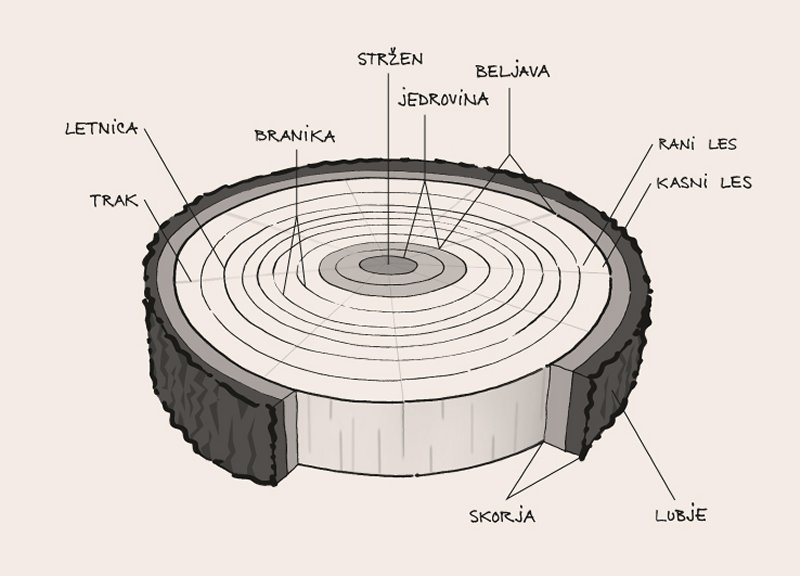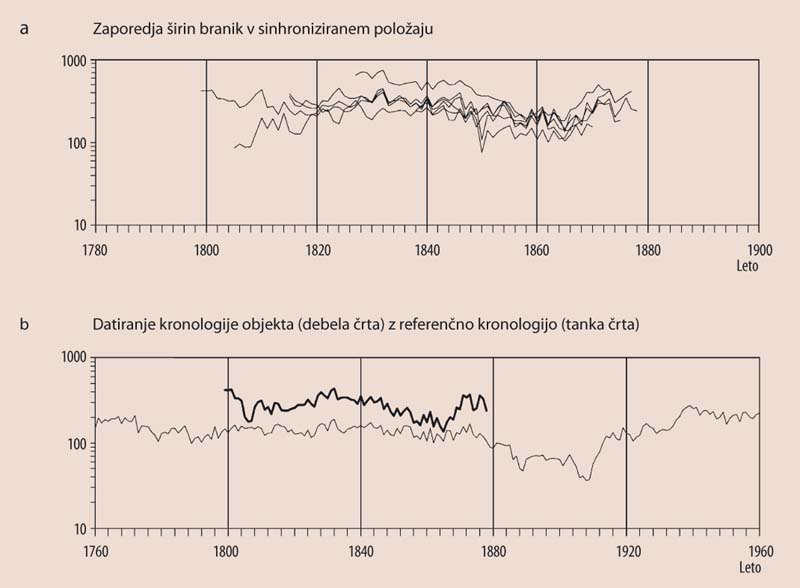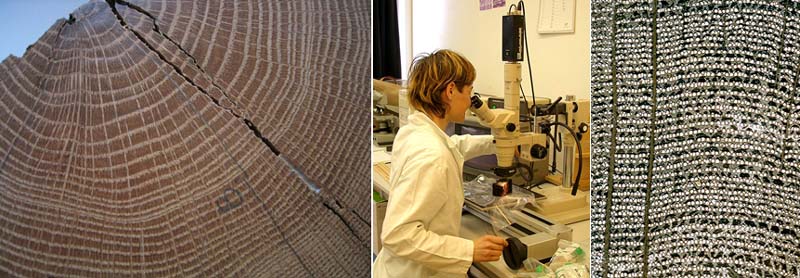Current research: Dendrochronology
Archaeobotany: Research equipment | Reference collection | Links | Pages for students and field archaeologists
Dendrochronology is a science that deals with the study of the tree rings in wood and makes it possible to determine the age of wood.
It is based on the fact that a tree forms one tree ring per a year (see figure below). The tree rings formed in different calendar years differ from each other in width. When conditions are favorable for wood formation, tree rings are wide; and when they are unfavorable, such as in extremely cold winters or dry summers, narrower tree rings are formed.

Cross-section of a tree trunk with typical anatomical elements of wood
Dendrochronological "tools" are charts of samples of different tree ring widths (called the chronology or sequence of tree rings widths), which are similar for trees of the same species from the same location and period of growth.

To date the wood, it is necessary to examine several samples of the same object (or the same archaeological site) and measure the widths of the tree rings. The result of measuring the tree rings is a chronology or sequence of tree rings widths, which is most easily represented in the form of a diagram with the years of growth on the X axis and the tree ring widths on the Y axis (see the figure above).
The graphs created in this way for each individual wood sample are then compared and synchronised. If we want to determine the year of origin of each the tree ring, we need to date the sequence of tree ring widths by visually and statistically comparing the graphs of tree rings widths with the corresponding reference chronology (see figure below).

Synchronization and dating
Reference chronologies should be established for each species, region, and time period.
If we do not have suitable reference chronologies or do not have a sufficiently large number of preserved tree rings in archeological wood that we want to date, we help ourselves with radiocarbon dating (see, e.g., Andrič M., Tolar T., Toškan B., Okoljska arheologija in paleoekologija: palinologija, arheobotanika in arheozoologija (Environmental archeology and paleoecology: palynology, archaeobotanics and archaeozoology), Ljubljana, 2016, 34).
The great advantage of previously dendrochronologically analyzed wood is that "we can significantly improve dating (in terms of accuracy, i.e., a narrower range of dated years) by correctly taking wood samples for 14C analysis and applying the "wiggle matching" method (see, e.g., ČUFAR, Katarina, TOLAR, Tjaša, 2006, 123-127). When working in the dendrochronology laboratory, we help with the dendrochronology table

References:
- Dendrochronological investigations at Ljubljansko barje pile-dwellings (Late Neolithic, Copper Age, Middle Bronze Age)
- VELUŠČEK, A., HORJAK ŠUŠTARŠIČ, M., TOLAR, T., TOŠKAN, B., MERELA, M., ČUFAR, K. 2023. Verd – novoodkrito kolišče iz 5. tisočletja pr. Kr. na Ljubljanskem barju / Verd – newly discovered pile-dwelling from the 5th millennium BC in Ljubljansko barje, Slovenia. − Les : revija za lesno gospodarstvo 30.
- ČUFAR, K., MERELA, M., KRŽE, L., VELUŠČEK, A. 2022. Dendrokronologija in absolutno datiranje kolišč na Ljubljanskem barju / Dendrochronology and absolute dating of pile-dwellings in Ljubljansko Barje. − Les/Wood 71/1, 57−70.
- ČUFAR, Katarina, KROMER, Bernd, TOLAR, Tjaša, VELUŠČEK, Anton. Dating of 4th millennium BC pile–dwellings on Ljubljansko barje, Slovenia. – J. archaeol. sci. 37, 2010, 2031–2039.
- GASPARI, Andrej, ČUFAR, Katarina, ERIČ, Miran, TOLAR, Tjaša. Predhodne arheološke in dendrokronološke raziskave na koliščarski naselbini Veliki Otavnik Ib pri Bistri = Preliminary archaeological and dendrochronological researches at the pile–dwelling settlement Veliki Otavnik Ib near Bistra. – In: VELUŠČEK, Anton (ur.). Koliščarska naselbina Stare gmajne in njen čas : Ljubljansko barje v 2. polovici 4. tisočletja pr. Kr. : the Ljubljansko barje in the 2nd half of the 4th millennium BC, (Opera Instituti archaeologici Sloveniae, 16). Ljubljana, 2009, 167–175.
- ČUFAR, Katarina, TOLAR, Tjaša. Raziskave lesa z Resnikovega prekopa in radiokarbonsko datiranje. V: VELUŠČEK, Anton (ed.),. Resnikov prekop : najstarejša koliščarska naselbina na Ljubljanskem barju = the oldest pile– dwelling settlement in the Ljubljansko barje,(Opera Instituti archaeologici Sloveniae, 10). Ljubljana, 2006, 123–127.
- Dendrochronological investigations at Roman Age sites in Slovenia (Vrhnika, Ljubljana)
- ČUFAR, Katarina, HORVAT, Jana, TOLAR, Tjaša, BERDEN, Tina, MERELA, Maks. Research potential of wood of barrels from Roman water wells = Raziskovalni potencial lesa sodov iz rimskih vodnjakov. − Les : revija za lesno gospodarstvo, ISSN 0024-1067. [Tiskana izd.], 2019, let. 68, št. 1, str. 47-60, ilustr. http://www.les-wood.si/index.php/leswood/article/view/66/43. [COBISS.SI-ID 3085193]
- Personal bibliography of Katarina Čufar